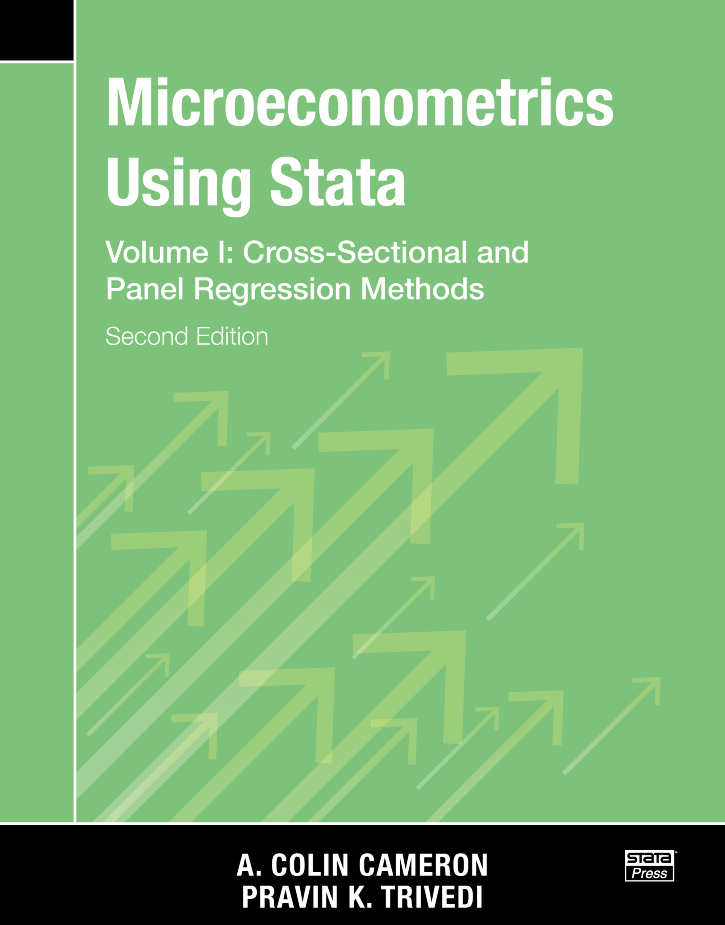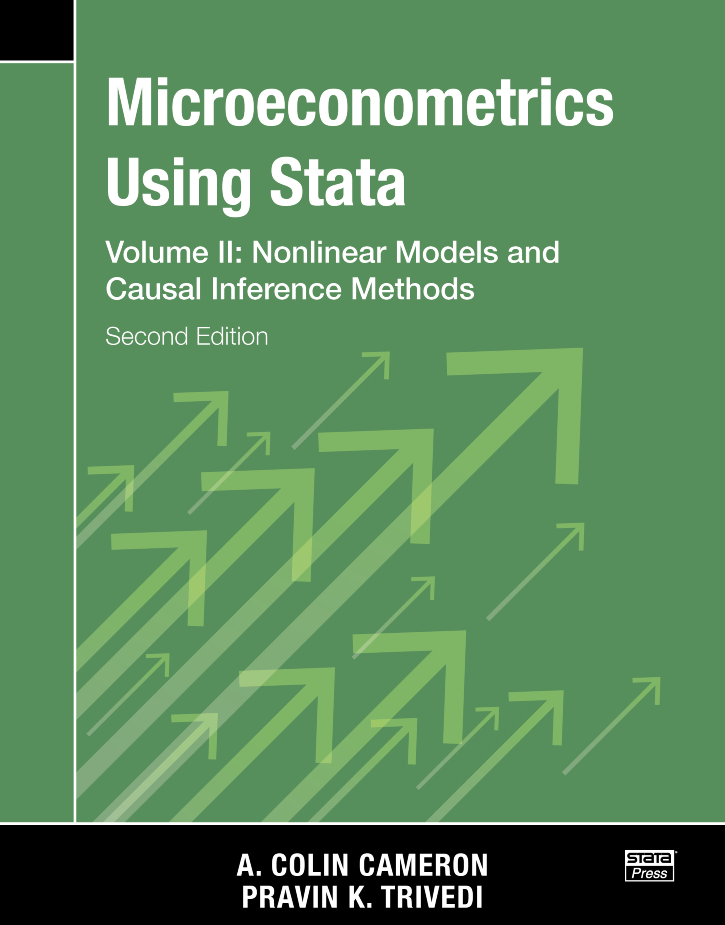A. Colin Cameron 和 Pravin K. Trivedi (作者)

• 出版社: Stata Press
• 平装: 1675页
• 语种: 英文
• ISBN: 9781597183598
• 条形码: 9781597183598
• 电子版:有
每一位使用 Stata 的应用经济研究人员和每一位教授或研究微观计量经济学的人都将从 Cameron 和 Trivedi 的两本书中受益。它们是使用 Stata 的微观计量经济学方法背后的理论和直觉的宝贵参考。熟悉 Cameron 和 Trivedi 的《 Microeconometrics: Methods and Applications》的人会发现同样的严谨性。那些熟悉上一版《Microeconometrics Using Stata》的人会发现熟悉的重点集中在 Stata 命令、它们的解释、它们与微观计量经济学理论的联系,以及计算概念的介绍,这些概念应该是任何研究人员工具箱的一部分。读者会发现更多内容——所以第二版增加了第二卷。
新版涵盖了自 2010 年上一版以来出现的与微观计量经济学相关的所有新 Stata 发展。例如,读者将找到关于治疗效果、持续时间模型、空间自回归模型、套索和贝叶斯分析的全新章节。但作者并没有就此止步。他们还讨论了Stata社区提供的最新微观经济计量方法。

第一卷介绍了基本的微观计量经济学方法,包括横截面数据的线性和非线性方法以及有无内生性的线性面板数据,以及假设和模型规格测试概述。除此之外,它还教授引导和模拟方法、分位数回归、有限混合模型和非参数回归。它还包括对基本 Stata 概念和编程的介绍,以及对 Mata 进行矩阵编程和基本优化的介绍。

第二卷以第一卷中介绍的方法为基础,引导读者了解在经济研究中有用的各种更先进的方法。首先介绍非线性优化方法,然后深入研究具有和不具有内生性的二元结果方法;有无内生性的tobit和选择模型估计;选择模型估计;计算条件均值的有无内生性的数据,计算条件分位数的数据;生存数据;具有和不具有内生性的非线性面板数据方法;外源和内源性治疗效果;空间数据建模;半参数回归;用于预测和推理的套索;和贝叶斯计量经济学。
随着其对现代计量经济学方法的百科全书式覆盖,以及演示如何在Stata中实施这些方法的许多工作示例,《Microeconometrics Using Stata, Second Edition》是一本,读者将为他们面临的每个新项目或分析反复阅读参考的书籍。它是应用研究人员和修读观计量经济学课程的人员的重要参考。
Colin Cameron 是加州大学戴维斯分校(University of California–Davis)的经济学教授,他在该校教授本科和研究生的计量经济学,以及健康经济学的本科课程。他在欧洲、澳大利亚、亚洲和南美洲开设短期课程。他的研究兴趣是微观计量经济学,尤其是具有聚类误差的回归稳健推断。他目前是《Stata Journal》的副主编。
Pravin K. Trivedi 是印第安纳大学布卢明顿分校(Indiana University–Bloomington)的杰出名誉教授和昆士兰大学经济学院(School of Economics at the University of Queensland)的名誉教授。在他的学术生涯中,他曾在美国、英国、欧洲和澳大利亚教授本科和研究生水平的计量经济学。他的研究兴趣包括微观计量经济学和健康经济学。他于 2000 年至 2007 年担任《Econometrics Journal》的共同主编,并于 1986 年至 2015 年担任《Journal of Applied Econometrics》的副主编。他与David Zimmer合着了《Copula Modeling in Econometrics: An Introduction for Practitioners》(2007 年)。
Cameron 和 Trivedi 的联合工作包括关于计量经济模型和计数数据检验的研究文章、计量经济学会专着《Regression Analysis of Count Data》和研究生级的书籍《Microeconometrics: Methods and Applications》。
List of tables
List of figures
Preface to the Second Edition
Preface to the First Edition
1 Stata basics
1.1 Interactive use
1.2 Documentation
1.3 Command syntax and operators
1.4 Do-files and log files
1.5 Scalars and matrices
1.6 Using results from Stata commands
1.7 Global and local macros
1.8 Looping commands
1.9 Mata and Python in Stata
1.10 Some useful commands
1.11 Template do-file
1.12 Community-contributed commands
1.13 Additional resources
1.14 Exercises
2 Data management and graphics
2.1 Introduction
2.2 Types of data
2.3 Inputting data
2.4 Data management
2.5 Manipulating datasets
2.6 Graphical display of data
2.7 Additional resources
2.8 Exercises
3 Linear regression basics
3.1 Introduction
3.2 Data and data summary
3.3 Transformation of data before regression
3.4 Linear regression
3.5 Basic regression analysis
3.6 Specification analysis
3.7 Specification tests
3.8 Sampling weights
3.9 OLS using Mata
3.10 Additional resources
3.11 Exercises
4 Linear regression extensions
4.1 Introduction
4.2 In-sample prediction
4.3 Out-of-sample prediction
4.4 Predictive margins
4.5 Marginal effects
4.6 Regression decomposition analysis
4.7 Shapley decomposition of relative regressor importance
4.8 Differences-in-differences estimators
4.9 Additional resources
4.10 Exercises
5 Simulation
5.1 Introduction
5.2 Pseudorandom-number generators
5.3 Distribution of the sample mean
5.4 Pseudorandom-number generators: Further details
5.5 Computing integrals
5.6 Simulation for regression: Introduction
5.7 Additional resources
5.8 Exercises
6 Linear regression with correlated errors
6.1 Introduction
6.2 Generalized least-squares and FGLS regression
6.3 Modeling heteroskedastic data
6.4 OLS for clustered data
6.5 FGLS estimators for clustered data
6.6 Fixed-effects estimator for clustered data
6.7 Linear mixed models for clustered data
6.8 Systems of linear regressions
6.9 Survey data: Weighting, clustering, and stratification
6.10 Additional resources
6.11 Exercises
7 Linear instrumental-variables regression
7.1 Introduction
7.2 Simultaneous equations model
7.3 Instrumental-variables estimation
7.4 Instrumental-variables example
7.5 Weak instruments
7.6 Diagnostics and tests for weak instruments
7.7 Inference with weak instruments
7.8 Finite sample inference with weak instruments
7.9 Other estimators
7.10 Three-stage least-squares systems estimation
7.11 Additional resources
7.12 Exercises
8 Linear panel-data models: Basics
8.1 Introduction
8.2 Panel-data methods overview
8.3 Summary of panel data
8.4 Pooled or population-averaged estimators
8.5 Fixed-effects or within estimator
8.6 Between estimator
8.7 Random-effects estimator
8.8 Comparison of estimators
8.9 First-difference estimator
8.10 Panel-data management
8.11 Additional resources
8.12 Exercises
9 Linear panel-data models: Extensions
9.1 Introduction
9.2 Panel IV estimation
9.3 Hausman–Taylor estimator
9.4 Arellano–Bond estimator
9.5 Long panels
9.6 Additional resources
9.7 Exercises
10 Introduction to nonlinear regression
10.1 Introduction
10.2 Binary outcome models
10.3 Probit model
10.4 MEs and coefficient interpretation
10.5 Logit model
10.6 Nonlinear least squares
10.7 Other nonlinear estimators
10.8 Additional resources
10.9 Exercises
11 Tests of hypotheses and model specification
11.1 Introduction
11.2 Critical values and p-values
11.3 Wald tests and confidence intervals
11.4 Likelihood-ratio tests
11.5 Lagrange multiplier test (or score test)
11.6 Multiple testing
11.7 Test size and power
11.8 The power onemean command for multiple regression
11.9 Specification tests
11.10 Permutation tests and randomization tests
11.11 Additional resources
11.12 Exercises
12 Bootstrap methods
12.1 Introduction
12.2 Bootstrap methods
12.3 Bootstrap pairs using the vce(bootstrap) option
12.4 Bootstrap pairs using the bootstrap command
12.5 Percentile-t bootstraps with asymptotic refinement
12.6 Wild bootstrap with asymptotic refinement
12.7 Bootstrap pairs using bsample and simulate
12.8 Alternative resampling schemes
12.9 The jackknife
12.10 Additional resources
12.11 Exercises
13 Nonlinear regression methods
13.1 Introduction
13.2 Nonlinear example: Doctor visits
13.3 Nonlinear regression methods
13.4 Different estimates of the VCE
13.5 Prediction
13.6 Predictive margins
13.7 Marginal effects
13.8 Model diagnostics
13.9 Clustered data
13.10 Additional resources
13.11 Exercises
14 Flexible regression: Finite mixtures and nonparametric
14.1 Introduction
14.2 Models based on finite mixtures
14.3 FMM example: Earnings of doctors
14.4 Global polynomials
14.5 Regression splines
14.6 Nonparametric regression
14.7 Partially parametric regression
14.8 Additional resources
14.9 Exercises
15 Quantile regression
15.1 Introduction
15.2 Conditional quantile regression
15.3 CQR for medical expenditures data
15.4 CQR for generated heteroskedastic data
15.5 Quantile treatment effects for a binary treatment
15.6 Additional resources
15.7 Exercises
A Programming in Stata
A.1 Stata matrix commands
A.2 Programs
A.3 Program debugging
A.4 Additional resources
B Mata
B.1 How to run Mata
B.2 Mata matrix commands
B.3 Programming in Mata
B.4 Additional resources
C Optimization in Mata
C.1 Mata moptimize() function
C.2 Mata optimize() function
C.3 Additional resources
Glossary of abbreviations
References
Author index
Subject index
List of tables
List of figures
16 Nonlinear optimization methods
16.1 Introduction
16.2 Newton–Raphson method
16.3 Gradient methods
16.4 Overview of ml, moptimize(), and optimize()
16.5 The ml command: lf method
16.6 Checking the program
16.7 The ml command: lf0–lf2, d0–d2, and gf0 methods
16.8 Nonlinear instrumental-variables (GMM) example
16.9 Additional resources
16.10 Exercises
17 Binary outcome models
17.1 Introduction
17.2 Some parametric models
17.3 Estimation
17.4 Example
17.5 Goodness of fit and prediction
17.6 Marginal effects
17.7 Clustered data
17.8 Additional models
17.9 Endogenous regressors
17.10 Grouped and aggregate data
17.11 Additional resources
17.12 Exercises
18 Multinomial models
18.1 Introduction
18.2 Multinomial models overview
18.3 Multinomial example: Choice of fishing mode
18.4 Multinomial logit model
18.5 Alternative-specific conditional logit model
18.6 Nested logit model
18.7 Multinomial probit model
18.8 Alternative-specific random-parameters logit
18.9 Ordered outcome models
18.10 Clustered data
18.11 Multivariate outcomes
18.12 Additional resources
18.13 Exercises
19 Tobit and selection models
19.1 Introduction
19.2 Tobit model
19.3 Tobit model example
19.4 Tobit for lognormal data
19.5 Two-part model in logs
19.6 Selection models
19.7 Nonnormal models of selection
19.8 Prediction from models with outcome in logs
19.9 Endogenous regressors
19.10 Missing data
19.11 Panel attrition
19.12 Additional resources
19.13 Exercises
20 Count-data models
20.1 Introduction
20.2 Modeling strategies for count data
20.3 Poisson and negative binomial models
20.4 Hurdle model
20.5 Finite-mixture models
20.6 Zero-inflated models
20.7 Endogenous regressors
20.8 Clustered data
20.9 Quantile regression for count data
20.10 Additional resources
20.11 Exercises
21 Survival analysis for duration data
21.1 Introduction
21.2 Data and data summary
21.3 Survivor and hazard functions
21.4 Semiparametric regression model
21.5 Fully parametric regression models
21.6 Multiple-records data
21.7 Discrete-time hazards logit model
21.8 Time-varying regressors
21.9 Clustered data
21.10 Additional resources
21.11 Exercises
22 Nonlinear panel models
22.1 Introduction
22.2 Nonlinear panel-data overview
22.3 Nonlinear panel-data example
22.4 Binary outcome and ordered outcome models
22.5 Tobit and interval-data models
22.6 Count-data models
22.7 Panel quantile regression
22.8 Endogenous regressors in nonlinear panel models
22.9 Additional resources
22.10 Exercises
23 Parametric models for heterogeneity and endogeneity
23.1 Introduction
23.2 Finite mixtures and unobserved heterogeneity
23.3 Empirical examples of FMMs
23.4 Nonlinear mixed-effects models
23.5 Structural equation models for linear structural equation models
23.6 Generalized structural equation models
23.7 ERM commands for endogeneity and selection
23.8 Additional resources
23.9 Exercises
24 Randomized control trials and exogenous treatment effects
24.1 Introduction
24.2 Potential outcomes
24.3 Randomized control trials
24.4 Regression in an RCT
24.5 Treatment evaluation with exogenous treatment
24.6 Treatment evaluation methods and estimators
24.7 Stata commands for treatment evaluation
24.8 Oregon Health Insurance Experiment example
24.9 Treatment-effect estimates using the OHIE data
24.10 Multilevel treatment effects
24.11 Conditional quantile TEs
24.12 Additional resources
24.13 Exercises
25 Endogenous treatment effects
25.1 Introduction
25.2 Parametric methods for endogenous treatment
25.3 ERM commands for endogenous treatment
25.4 ET commands for binary endogenous treatment
25.5 The LATE estimator for heterogeneous effects
25.6 Difference-in-differences and synthetic control
25.7 Regression discontinuity design
25.8 Conditional quantile regression with endogenous regressors
25.9 Unconditional quantiles
25.10 Additional resources
25.11 Exercises
26 Spatial regression
26.1 Introduction
26.2 Overview of spatial regression models
26.3 Geospatial data
26.4 The spatial weighting matrix
26.5 OLS regression and test for spatial correlation
26.6 Spatial dependence in the error
26.7 Spatial autocorrelation regression models
26.8 Spatial instrumental variables
26.9 Spatial panel-data models
26.10 Additional resources
26.11 Exercises
27 Semiparametric regression
27.1 Introduction
27.2 Kernel regression
27.3 Series regression
27.4 Nonparametric single regressor example
27.5 Nonparametric multiple regressor example
27.6 Partial linear model
27.7 Single-index model
27.8 Generalized additive models
27.9 Additional resources
27.10 Exercises
28 Machine learning for prediction and inference
28.1 Introduction
28.2 Measuring the predictive ability of a model
28.3 Shrinkage estimators
28.4 Prediction using lasso, ridge, and elasticnet
28.5 Dimension reduction
28.6 Machine learning methods for prediction
28.7 Prediction application
28.8 Machine learning for inference in partial linear model
28.9 Machine learning for inference in other models
28.10 Additional resources
28.11 Exercises
29 Bayesian methods: Basics
29.1 Introduction
29.2 Bayesian introductory example
29.3 Bayesian methods overview
29.4 An i.i.d. example
29.5 Linear regression
29.6 A linear regression example
29.7 Modifying the MH algorithm
29.8 RE model
29.9 Bayesian model selection
29.10 Bayesian prediction
29.11 Probit example
29.12 Additional resources
29.13 Exercises
30 Bayesian methods: Markov chain Monte Carlo algorithms
30.1 Introduction
30.2 User-provided log likelihood
30.3 MH algorithm in Mata
30.4 Data augmentation and the Gibbs sampler in Mata
30.5 Multiple imputation
30.6 Multiple-imputation example
30.7 Additional resources
30.8 Exercises
Glossary of abbreviations
References
 北京友万信息科技有限公司,英文全称:Beijing Uone Info&Tech Co.,Ltd ( Uone-Tech )是中国大陆领先的教育和科学软件分销商,已在中国300多所高校建立了可靠的分销渠道。拥有最成功的教学资源和数据管理专家。如需申请软件采购及老版本更新升级请联系我们,咨询热线:010-56548231 ,咨询邮箱:info@uone-tech.cn 感谢您的支持与关注。
北京友万信息科技有限公司,英文全称:Beijing Uone Info&Tech Co.,Ltd ( Uone-Tech )是中国大陆领先的教育和科学软件分销商,已在中国300多所高校建立了可靠的分销渠道。拥有最成功的教学资源和数据管理专家。如需申请软件采购及老版本更新升级请联系我们,咨询热线:010-56548231 ,咨询邮箱:info@uone-tech.cn 感谢您的支持与关注。